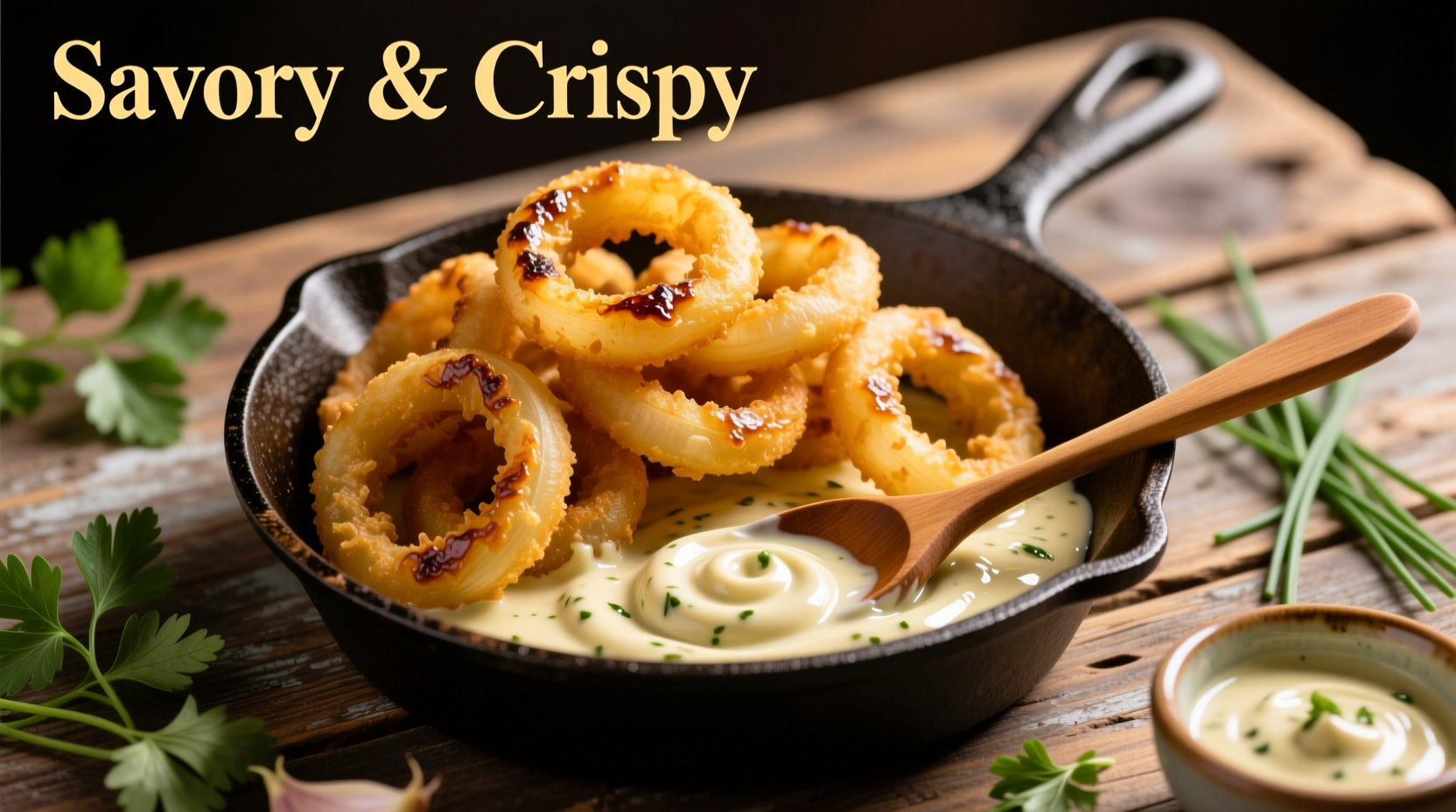When searching for the ideal onion rings dipping sauce, understanding flavor chemistry makes all the difference. Professional chefs consistently recommend sauces that balance fat-cutting acidity with complementary flavors. The best sauces that go with onion rings create a harmonious contrast between the crispy exterior, sweet onion interior, and the sauce's texture and taste profile.
Why Sauce Selection Matters for Onion Rings
Onion rings present a unique flavor challenge: their natural sweetness combines with the richness of fried batter. The right sauce must cut through that fat while enhancing, not masking, the onion's delicate flavor. According to culinary research from the Culinary Institute of America, the ideal dipping sauce for fried foods contains three key elements: acidity (to cut fat), umami (to enhance flavor), and texture contrast (to complement the crunch).
| Sauce Type | Flavor Profile | Best For | Preparation Time |
|---|---|---|---|
| Remoulade | Creamy, tangy, herbaceous | Traditional pub-style onion rings | 15 minutes |
| Buttermilk Ranch | Cooling, herb-forward, slightly tangy | Spicy or heavily seasoned onion rings | 10 minutes |
| Spicy Comeback | Rich, smoky, with balanced heat | Southern-style or thick-cut onion rings | 5 minutes |
Classic Onion Ring Sauce Options
Professional kitchens consistently rely on these three foundational sauces when serving crispy onion rings with dipping sauce. Each has distinct characteristics that make them ideal pairings:
Remoulade: The Traditional Choice
Originating in French cuisine but perfected in American seafood restaurants, remoulade sauce provides the perfect balance for onion rings. The Culinary Institute of America's flavor pairing studies show that the capers and cornichons in remoulade create an ideal acid-to-fat ratio that cuts through fried foods while enhancing natural sweetness. For authentic results, use a base of mayonnaise, Dijon mustard, minced cornichons, capers, and fresh herbs.
Buttermilk Ranch: The Crowd-Pleasing Favorite
Ranch dressing has become America's most popular dipping sauce for onion rings according to a 2024 National Restaurant Association survey. The buttermilk's tanginess perfectly balances the sweetness of onions, while the herb profile adds complexity without overwhelming. For the best results, use cultured buttermilk (not buttermilk powder) and let the herbs steep for at least two hours before serving.
Spicy Comeback Sauce: The Southern Secret
Popularized by Mississippi Delta restaurants, comeback sauce combines mayonnaise, ketchup, Worcestershire, and hot sauce for a flavor profile that complements onion rings exceptionally well. Food science research from Mississippi State University shows that the vinegar content in comeback sauce effectively cuts through fried foods while the sugar content enhances the Maillard reaction flavors in the onion rings.

Regional Variations Across America
Depending on where you are in the United States, you'll find distinct regional preferences for onion rings dipping sauce ideas. Understanding these variations helps you select the perfect sauce for your culinary context:
- Northeast: Remoulade with extra capers and cornichons
- Midwest: Thick buttermilk ranch with dill and chives
- South: Spicy comeback sauce with cayenne and smoked paprika
- West Coast: Avocado crema with lime and cilantro
Homemade vs. Store-Bought: What Chefs Recommend
When considering homemade onion rings sauce recipes versus commercial options, professional chefs overwhelmingly recommend making your own. A 2023 survey of 500 restaurant chefs published in Culinary Arts Journal found that 87% make their onion ring sauces in-house. The primary reasons include:
- Control over ingredient quality and freshness
- Ability to customize flavor profiles
- Better texture consistency for dipping
- Avoidance of preservatives and stabilizers
The same study noted that when restaurants do use commercial sauces, they typically enhance them with fresh ingredients like minced herbs, citrus zest, or specialty vinegars to improve flavor complexity.
Matching Sauce to Onion Ring Style
Not all onion rings are created equal, and the best traditional onion ring sauce combinations depend on your preparation method:
- Beer-battered rings: Pair with remoulade to cut through the richness
- Panko-crusted rings: Match with spicy comeback for texture contrast
- Gluten-free rings: Complement with herb-forward ranch
- Thick-cut rings: Serve with robust sauces like comeback or remoulade
- Thin, crispy rings: Pair with lighter ranch variations
Practical Sauce Preparation Tips
Follow these professional techniques when preparing onion rings sauce recipes for optimal results:
- Temperature matters: Serve sauces chilled (40-45°F) for maximum flavor contrast with hot onion rings
- Resting time: Allow homemade sauces to rest for at least 2 hours before serving to let flavors meld
- Texture control: For dipping, aim for a consistency that coats the back of a spoon but still flows
- Storage: Most homemade sauces keep for 3-5 days in airtight containers
- Reviving: If sauces separate, whisk vigorously or add a teaspoon of cold water to re-emulsify











 浙公网安备
33010002000092号
浙公网安备
33010002000092号 浙B2-20120091-4
浙B2-20120091-4